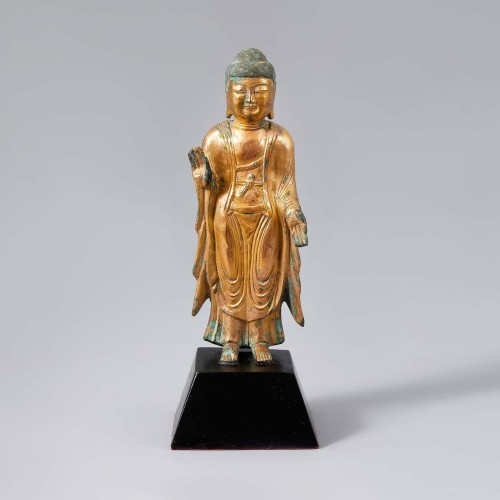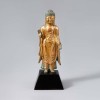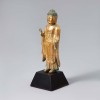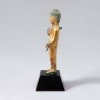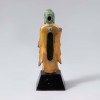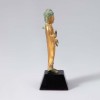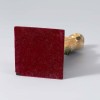본문
작품 정보
간결하면서도 균형 잡힌 형태, 은은한 미소가 특징인 삼국시대 금동여래입상(金銅如來立像)입니다.
큼직한 육계(肉髻), 둥글고 풍만한 얼굴과 작은 몸체, 은은한 미소를 통해 이상화된 부처의 형상을 표현했습니다. 육계는 깨달음을 상징하며, 비현실적인 신체 비례와 자비로움을 담은 표정은 부처의 신성을 나타냅니다.
법의는 통견식(通肩式)으로 양쪽 어깨를 덮고 의문(衣紋)은 간결합니다. 시무외인(施無畏印)과 여원인(與願印)을 취한 수인은 중생의 고통을 덜고 소원을 성취하게 한다는 불교적 의미를 담고 있습니다.
불상은 내부를 비운 중공식(中空式)으로 주조되었으며, 외부에는 금을 입혀 시각적 장엄성과 종교적 권위를 드러냅니다.
━━━━━
此金铜如来立像为朝鲜三国时代的文物,简洁而匀称的造型与柔和的微笑为其主要特征。
佛像头顶高耸的肉髻象征觉悟之意,圆润丰满的面庞、相对小巧的身形,以及含蓄的微笑,共同勾勒出一种理想化的佛陀形象。佛的非写实身体比例与富有慈悲的神情,体现了其超凡脱俗的神性。
所穿法衣为通肩式,覆盖双肩,衣纹线条简洁流畅。佛像双手结施无畏印与与愿印,寓意解除众生苦难,成就其愿望的佛教理念。
此像采用中空铸造工艺,表面施以鎏金处理,彰显其宗教的庄严与神圣权威。
━━━━━
This Gilt-Bronze Standing Buddha from the Three Kingdoms period features a balanced and simple form, distinguished by its serene smile.
The Buddha has a large usnisa (topknot), a round and full face, a small body, and a subtle smile, all contributing to an idealized depiction of the enlightened being. The usnisa symbolizes spiritual awakening, and the stylized body proportions and compassionate expression convey the divine nature of the Buddha.
The robe is in the tonggyeon-sik (covering both shoulders) style, with simple drapery lines. The hand gestures (mudra)—abhaya (dispelling fear) and varada (granting wishes)—represent the Buddhist promise to alleviate suffering and fulfill aspirations.
The hollow-cast structure and the application of gold to the surface highlight both the visual grandeur and spiritual authority of the sculpture.
CONDITION
NOTICE
상담/문의 : 02- 730-5601 / 02- 730-7566 